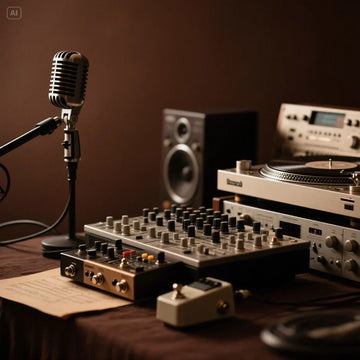What Is Lo-Fi Music and Why It’s Trending

Lo-fi music isn’t about technical perfection — it’s about feeling. It’s the sound of imperfections left in on purpose: vinyl crackle, dusty drum loops, warbly synths, and slightly off-pitch melodies that feel human. These elements create a warm, nostalgic atmosphere that connects with listeners on an emotional level.
At its core, lo-fi is raw and intimate. You’ll often hear ambient background noise, tape hiss, or detuned textures, not by accident, but by design. The goal isn’t to polish everything to perfection but to make something that feels real and deeply personal.
Why Lo-Fi Resonates with Modern Producers
Lo-fi’s popularity exploded alongside chillhop and study beats playlists — not just because it sounds good, but because it’s accessible. You don’t need a professional studio or expensive gear to get started. A laptop, a DAW, and the right sound kits are enough to make music that lives and breathes.
More than a genre, lo-fi has become a creative escape. It gives producers freedom from technical pressure, a space to focus on mood, tone, and vibe. Whether you're uploading to YouTube, streaming on Spotify, or just making music for yourself, lo-fi invites you to create without overthinking.
Here’s your next section, crafted with a relaxed, authentic tone that speaks directly to lo-fi producers — and keeps your product mentions natural and value-driven:
Choosing the Right Drum Sounds
Lo-fi drums aren’t meant to be spotless or perfect, they’re meant to carry character. In fact, the imperfections are what make them feel real. Whether it’s a little tape saturation, a touch of room noise, or swing that doesn’t quite hit the grid, lo-fi drums should feel dusty, warm, and human.
Importance of Drum Texture in Lo-Fi
What separates a lo-fi beat from just a simple loop? Texture. The best lo-fi drums carry a certain grit, the sound of vinyl breaks, cassette compression, or 12-bit samplers that slightly degrade the audio in just the right way. Swing is essential too. A tight groove with slightly off-kilter hats or ghost snares creates that relaxed, head-nodding feel lo-fi is known for. If your drums are too clean, too polished, or too rigid, you’ll lose the vibe. That’s why analog-style kits make all the difference.
Recommended Sound Kits
Lo-Fi & Funky Sound Kit – Packed with crunchy breaks, dusty snares, and perfectly imperfect textures that feel lifted from an old crate.
dOPe-1 LoFi Sound Kit – Built for rawness. Think 12-bit punch, slightly degraded transients, and bold drum presence that cuts through.
LoFi Load & Go – For instant groove. Pre-made swung loops you can drop in and build around — no need to program from scratch.
One-Shots vs Loops
Both have their place in a solid lo-fi workflow: One-shots are ideal if you like building from the ground up. They let you control every hit, every placement, every swing. Loops offer instant inspiration. They’re great for when you want to start with a groove and layer from there, especially useful when ideas need to flow fast. Here’s your next full section — smooth, expressive, and naturally infused with product relevance for 12 Bit Soul:
Crafting Melodic Loops That Set the Mood
In lo-fi, melody is more about mood than complexity. You’re not trying to show off theory, you’re trying to say something with sound. The right loop can instantly shift the atmosphere, creating space, warmth, and emotion even before the drums drop. It’s about choosing the right textures and letting them breathe.
Elements That Work Well in Lo-Fi Melodies
- Lo-fi melodies tend to lean nostalgic, soulful, and a little worn-in. Think:
-
Jazzy chords on Rhodes or Wurlitzer keys
-
Reversed guitar plucks or bell tones
-
Detuned pads that feel like cassette tape
-
Pitch-shifted vocal chops or phrases that sound lifted from vinyl
This is where imperfection adds magic, whether it’s a pad with a slight wobble or a loop that feels warped like an old VHS.
Creative Techniques
-
Add wow/flutter effects for tape-style pitch drift
-
Use long reverb tails to soften transitions
-
Chop and rearrange melodic phrases for uniqueness
-
Reverse short segments for dreamy transitions
-
Layer subtle vinyl noise or ambient room hiss underneath
Let your loops do less. but feel more.
Setting the Right Tempo and Swing
Lo-fi isn’t in a rush. It lives in that pocket between laid-back and looped-up. Whether you’re building a sleepy beat to study to or something soulful to nod to, timing matters.
Ideal BPM Range
Most lo-fi tracks live between 60 and 85 BPM, giving you room to layer and swing. Alternatively, many producers build at double time—creating in the 120–170 BPM range and programming with half-time groove. It gives you flexibility in drum programming while still keeping that chill feel.
Using Swing to Humanize the Groove
- Shift snares slightly off-grid to create a pocket
- Add velocity variation in hi-hats to avoid robotic repetition
- Delay claps, ghost snares, or kicks by milliseconds to build groove
-
Use triplet rolls or micro-timing tweaks for loose rhythm
Lo-Fi Kits with Built-In Groove
LoFi Load & Go – Packed with pre-swinged loops, perfect for producers who want to skip the grid and dive right into a real-feeling bounce. Avoid over-quantizing. Let the groove breathe. Let the loop lean a little. Here’s your next full section, smooth, expressive, and naturally infused with product relevance for 12 Bit Soul:
Crafting Melodic Loops That Set the Mood
In lo-fi, melody is more about mood than complexity. You’re not trying to show off theory—you’re trying to say something with sound. The right loop can instantly shift the atmosphere, creating space, warmth, and emotion even before the drums drop. It’s about choosing the right textures and letting them breathe.
Elements That Work Well in Lo-Fi Melodies
Lo-fi melodies tend to lean nostalgic, soulful, and a little worn-in. Think:
- Jazzy chords on Rhodes or Wurlitzer keys
- Reversed guitar plucks or bell tones
-
Detuned pads that feel like cassette tape
-
Pitch-shifted vocal chops or phrases that sound lifted from vinyl
This is where imperfection adds magic, whether it’s a pad with a slight wobble or a loop that feels warped like an old VHS.
Recommended Kits for Melody
- Psychedelic Soul Vol. 1 & 2 – Designed for emotional depth. Warped chords, grainy textures, and moody loops that layer beautifully with lo-fi drums.
-
Cinematic Soul – Lush, atmospheric, and full of soul. Perfect for creating layered moments in chillhop, ambient, or instrumental storytelling.
Creative Techniques
-
Add wow/flutter effects for tape-style pitch drift
-
Use long reverb tails to soften transitions
-
Chop and rearrange melodic phrases for uniqueness
-
Reverse short segments for dreamy transitions
-
Layer subtle vinyl noise or ambient room hiss underneath
Let your loops do less—but feel more.
Setting the Right Tempo and Swing
Lo-fi isn’t in a rush. It lives in that pocket between laid-back and looped-up. Whether you’re building a sleepy beat to study to or something soulful to nod to, timing matters.
Ideal BPM Range
Most lo-fi tracks live between 60 and 85 BPM, giving you room to layer and swing. Alternatively, many producers build at double time—creating in the 120–170 BPM range and programming with half-time groove. It gives you flexibility in drum programming while still keeping that chill feel.
Using Swing to Humanize the Groove
-
Shift snares slightly off-grid to create a pocket
-
Add velocity variation in hi-hats to avoid robotic repetition
-
Delay claps, ghost snares, or kicks by milliseconds to build groove
-
Use triplet rolls or micro-timing tweaks for loose rhythm
Adding Noise, Saturation, and Ambience
What gives lo-fi its charm isn’t just the melody or groove — it’s the textures that wrap around the track. The crackle of vinyl, the warmth of analog gear, the slight wobble in pitch — these subtle imperfections are what make the music feel real. It’s about creating mood through imperfection, not chasing studio-level polish.
Analog-Style Sound Design Essentials
To achieve that rich analog tone, start by layering real-world textures:
-
Vinyl crackle, amp hiss, or room tone instantly warm up a clean mix
-
Subtle clipping or drive on instruments brings harmonic richness
-
Background elements like field recordings or tape hum help glue the track together
Think of it like adding seasoning — you want just enough to give it flavor, not overwhelm the dish.
Built-in Texture in 12 Bit Soul Kits
One of the easiest ways to get this vibe is to start with sound kits that already carry analog color. That’s where 12 Bit Soul kits stand out. Many of them are pre-processed with natural saturation, EQ shaping, and tape-style warmth, so you can drop them in and build without needing 10 plugins just to get character.
Suggested Plugins (Optional Enhancements)
If you want to fine-tune or experiment more, here are a few plugins lo-fi producers swear by:
-
RC-20 Retro Color – adds pitch wobble, distortion, and mechanical texture
-
iZotope Vinyl – great for adding classic record crackle and environmental noise
-
Decimort 2 – perfect for achieving crunchy 12-bit tone and color
Tip: Use EQ after adding these effects to tame harsh highs, and preserve warm midrange tones that sit beautifully in the mix.
Vocals in Lo-Fi (Optional Layer)
Vocals in lo-fi music don’t dominate the track — they complement it. Whether you’re working with sampled phrases, lo-fi rap verses, or ambient vocal loops, the treatment is key. They should feel like another layer of texture rather than a lead spotlight.
What Kind of Vocals Fit Lo-Fi
-
Soft-toned or whispery rap works well
-
Chopped spoken word or dialogue clips from old records, movies, or YouTube
-
Filtered or reversed phrases used as melodic elements or atmosphere
The best lo-fi vocals feel almost like memories—faint, emotional, and textured.
How to Treat Vocals for Texture
-
Apply spring reverb or slapback delay for a vintage feel
-
Use low-pass filtering to make vocals sit in the mix, not stand out too sharp
-
Chop vocal samples rhythmically or stretch them for ambient pads
-
Blend with background hiss or reverb tails to give that dreamy softness
Mixing Without Killing the Vibe
The mix in lo-fi isn’t meant to be sterile — it’s meant to breathe. If you over-edit, you risk removing the very soul of the track. Instead, aim to enhance the mood without getting in its way.
Keep It Simple
Stick to a minimalist approach:
-
High-pass EQ for non-bass elements (around 100Hz)
-
Light compression to smooth out peaks, not squash dynamics
-
Tape hiss or vinyl noise to glue the track subtly
-
Use reverb sends, not inserts, to maintain clarity while adding space
Prioritize the Feel Over Perfection
Let the swing swing. Let the textures breathe. Don't be afraid of little timing imperfections, they often make the groove feel more human.
-
Don’t quantize everything to the grid
-
Leave small pockets of space between sounds
-
Let each element tell a part of the story
Basic Mixing Chain for Lo-Fi
Here’s a simple chain that gets the job done without losing feel:
-
High-pass EQ to clean up lows on melodic and vocal elements
-
Subtle compression for cohesion (slow attack, medium release)
-
Saturation or analog-style drive to warm things up
-
Reverb on a bus channel for ambient cohesion
-
Noise layer (vinyl crackle or field recordings) to tie it all together
What They Teach Us
If there’s one thing the lo-fi greats show us — from J Dilla’s grooves to Nujabes’ jazz-infused textures — it’s this: don’t overthink it.
-
Keep it soulful, not busy – Leave space, let loops repeat, and trust the groove
-
Feel over perfection – The best lo-fi tracks aren’t flawless; they’re emotional
-
Imperfection tells a story – A pitched-down sample or a slightly swung snare creates connection
Lo-fi isn’t about doing more. It’s about doing less — with intention.
Final Thoughts
You don’t need a full studio or endless plugins to make lo-fi music that resonates. What you do need are the right building blocks, sounds that already carry the texture, swing, and warmth lo-fi is built on. Here are some of the best kits to kickstart your creative process:
Start Producing Lo-Fi Music the Right Way
Want to skip the endless plugin tweaking and get straight to the vibe?
Explore premium analog-style sound kits at 12bitsoul.com — crafted for producers who want their music to feel like something.
FAQs
What is lo-fi music and why is it so popular?
Lo-fi music emphasizes emotional atmosphere over technical perfection. It’s popular for its nostalgic, relaxing sound—perfect for studying, working, or vibing out.
What gear do I need to make lo-fi music at home?
A basic DAW, MIDI controller, headphones, and high-quality sound kits are enough. You don’t need fancy equipment to make beautiful, soulful music.
How do I make my music sound lo-fi?
Use analog-style drum kits, detuned melodies, vinyl crackle, and subtle saturation. Let imperfection shine and avoid over-polishing your mix.
What BPM should I use for lo-fi beats?
Most lo-fi tracks range from 60 to 85 BPM, or double-time grooves at 120–170 BPM with a chill half-time feel.
Do I need to add noise or crackle manually?
Not if you're using kits from 12 Bit Soul — many come with built-in texture. But you can layer in vinyl crackle or room hiss for added warmth.
Can I use vocals in lo-fi music?
Yes — soft rap verses, chopped vocal samples, or filtered speech can add depth. Just keep them subtle and atmospheric.
Is EQ important when making lo-fi music?
Absolutely — but keep it minimal. Use high-pass EQ to clean up low-end clutter and focus on midrange warmth for that analog feel.
No comments









0 comments